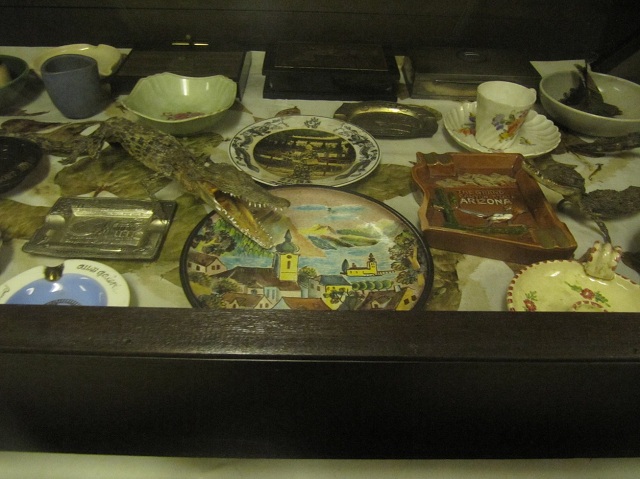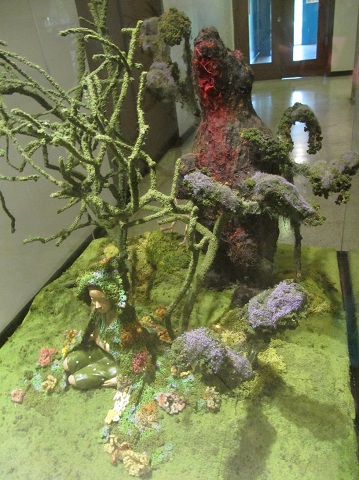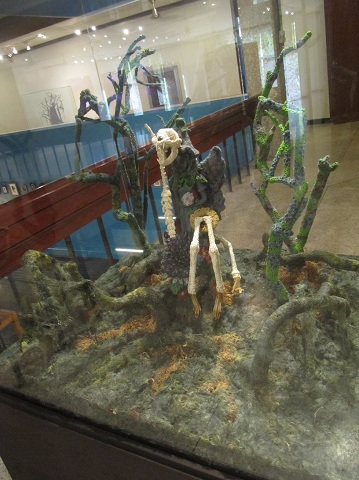Filtered By: Lifestyle
Lifestyle
The failed haunting in Geraldine Javier’s 'Curiosities'
Text and photos by Katrina Stuart Santiago
By the time you realize what this exhibit was doing, it will be too late. That is, you will have peered far longer than you should at the jars filling those cabinets, you will have already spent way too much time taking pictures.

Stuffed reptiles in "Vargas Exposed"
It’s really an exhibit made of collections of all sorts: shelves and dioramas installed with miniatures, lithography of leaves, stuffed birds and cat skeletons. These are reason enough for curiosity, but what you find as you walk through the sections of this exhibit is that it is consistently about whimsy too, about the hobbies of our youth, if not those imposed on us by classes in arts and crafts and sewing. As such it is color and death, it is a bizarre kind of fancy, that will push you to walk from one part of this exhibit to another. Shaking your head at the person who even thought to collect these vestiges of the dead. Surprised at how it is cared for and cradled by the task of creation that is in these crafts projects. It is like a haunted house that you cannot but be interested in. By the time you find out its haunting, it will be too late. Madame A as collector What greets you at the third floor landing of the museum stairs is a set of birds embroidered on cloth and stretched onto small round frames. It is reminiscent of the richness of old detailed and heavy needlework on lush fabric, and in this set of seemingly miniature frames, all lined up against a wall, it looks like a project now done, a hobby that was fleeting.  A tree without leaves greets you at the third floor, as do six shelves called “Cabinet of Curiosities” all attributed to Madame A. Against the afternoon sunlight streaming through windows covered by delicate handcrafted curtains with dried leaves, the effect is eerie. It is an empty hallway of a huge home, one that does not welcome you in. But you are already there, and you are left with nothing but curiosity. The shelves carry all kinds of vitrines and containers, jars and vases; from afar it seems like nothing but a collection, the kind that we see in most Filipino homes. But there is something whimsical about the way each shelf looks, where there is always a splash of color, a seemingly familiar form, if not a play on a particular scene we already have in our heads. Something will catch your fancy; these shelves will draw you in. Into a world all its own, where the remains of small insects and creatures – some skeletons and others preserved – are the central characters in what are miniature installations reminiscent of the tales of our childhood. You get goosebumps and want to turn away at this display of death; you find that you can’t. These miniatures are too fascinating, even when they are insects and frogs and creepy crawlies. And you cannot but take a look up close, your eyes drawn to figures ensconced in dried and recreated fauna. Here is Madame A’s hand, careful and deliberate, one that did not over do any one installation on any one shelf, where creaturely remains are re-crafted as part of what looks like the capricious act of collecting. Madame A’s worlds Around these shelves, spread sporadically, are versions of the dioramas we used to make in elementary school, central to each one is a large creature, skeletal and female doll. These are reconfigurations of nature goddesses, the kinds that are familiar but here are also all new. The “Cat Fairy” works with a real cat skeleton in a creepy diorama of a seemingly dank and destitute forest. The “Fallen Angel” is the figure of a woman enveloped by a dark seemingly dead and tired forest. “Madame A and the Hungry Bear” is a colorful diorama of greenery and colorful flora, at the center of which sits a girl who, unbeknownst to her, is about to be attacked by a bear from behind, the body of which is already dripping with blood. Here we are reminded of how Madame A is not just collector, as she is creator. She creates worlds in these dioramas, and these are worlds – bizarre but built on a common reality we have with her. These are worlds that are strange and creepy, but we know of these to be true for spaces other than the city we live in, if not as spaces that are in our heads.
A tree without leaves greets you at the third floor, as do six shelves called “Cabinet of Curiosities” all attributed to Madame A. Against the afternoon sunlight streaming through windows covered by delicate handcrafted curtains with dried leaves, the effect is eerie. It is an empty hallway of a huge home, one that does not welcome you in. But you are already there, and you are left with nothing but curiosity. The shelves carry all kinds of vitrines and containers, jars and vases; from afar it seems like nothing but a collection, the kind that we see in most Filipino homes. But there is something whimsical about the way each shelf looks, where there is always a splash of color, a seemingly familiar form, if not a play on a particular scene we already have in our heads. Something will catch your fancy; these shelves will draw you in. Into a world all its own, where the remains of small insects and creatures – some skeletons and others preserved – are the central characters in what are miniature installations reminiscent of the tales of our childhood. You get goosebumps and want to turn away at this display of death; you find that you can’t. These miniatures are too fascinating, even when they are insects and frogs and creepy crawlies. And you cannot but take a look up close, your eyes drawn to figures ensconced in dried and recreated fauna. Here is Madame A’s hand, careful and deliberate, one that did not over do any one installation on any one shelf, where creaturely remains are re-crafted as part of what looks like the capricious act of collecting. Madame A’s worlds Around these shelves, spread sporadically, are versions of the dioramas we used to make in elementary school, central to each one is a large creature, skeletal and female doll. These are reconfigurations of nature goddesses, the kinds that are familiar but here are also all new. The “Cat Fairy” works with a real cat skeleton in a creepy diorama of a seemingly dank and destitute forest. The “Fallen Angel” is the figure of a woman enveloped by a dark seemingly dead and tired forest. “Madame A and the Hungry Bear” is a colorful diorama of greenery and colorful flora, at the center of which sits a girl who, unbeknownst to her, is about to be attacked by a bear from behind, the body of which is already dripping with blood. Here we are reminded of how Madame A is not just collector, as she is creator. She creates worlds in these dioramas, and these are worlds – bizarre but built on a common reality we have with her. These are worlds that are strange and creepy, but we know of these to be true for spaces other than the city we live in, if not as spaces that are in our heads.  Within one room, Madame A’s collection of stuffed birds become part of intermedia canvasses, with dried leaves and twigs. One glass case carries a bird seemingly ready for burial, wrapped carefully in tatting. At the center of the room, amidst other works of lithography, is a divider hammered with dried leaves. Hanging on either side are cradles: one cradle carries a two-dimensional doll that looks dead, the other cradle carries the skeleton of a creature all nestled and wrapped in handmade lace. The sunshine streaming into this airconditioned room balances the darkness of the dead that it lives off. There is life here. One might actually feel it breathing. Madame A is dead As the creator seems to be, where there is a sense of Madame A as a woman who is alive, engaging with the world through these works. Up to this point, it is Madame A and not Javier that one comes to know as artist. For most the exhibit we are made to imagine this woman alive, owner of this space filled with skeletons and dioramas, installations and crochet, the remains and reconfigurations of creatures strange and familiar. In the last space that is part of this exhibit, Madame A is brought to life in a short film, rendering her as real, but also explaining what had become of her, why she had become the things in that space. It would be wonderful were it not such an … explanation, one that is too melodramatic for comfort, if not too filled with soap opera stereotyping and drama. This is where this exhibit falters, and how ironic that it is in the form within which she would be most alive, that in fact she is killed. Because instead of leaving Madame A to be defined by the work here, she is made into subject and object, in a film where other voices speak about her. She loses all mystery. As such, by the time one is led to the library that carries “Vargas Exposed” the fiction of Madame A has been lost, and it becomes nothing but the work of Javier, re-collecting and wrapping what are part of Jorge Vargas’ collection of everything, from trinkets like keychains to old keys, ashtrays and travel souvenirs, photographs and memorabilia. At this point you cannot but know that this is all Javier working on her own sense of whimsy, and Madame A is long gone, the character her work outside built now questionable, the eeriness of the works now disappeared. To some extent it’s like you’ve bought a ticket into the horror house, only to find that it is far from being scary. At this point you also find that you’ve lost all curiosity. — BM, GMA News “Curiosities” by Geraldine Javier ran at the UP Vargas Museum’s 3rd Floor Galleries and Library in February to April 2013.
Within one room, Madame A’s collection of stuffed birds become part of intermedia canvasses, with dried leaves and twigs. One glass case carries a bird seemingly ready for burial, wrapped carefully in tatting. At the center of the room, amidst other works of lithography, is a divider hammered with dried leaves. Hanging on either side are cradles: one cradle carries a two-dimensional doll that looks dead, the other cradle carries the skeleton of a creature all nestled and wrapped in handmade lace. The sunshine streaming into this airconditioned room balances the darkness of the dead that it lives off. There is life here. One might actually feel it breathing. Madame A is dead As the creator seems to be, where there is a sense of Madame A as a woman who is alive, engaging with the world through these works. Up to this point, it is Madame A and not Javier that one comes to know as artist. For most the exhibit we are made to imagine this woman alive, owner of this space filled with skeletons and dioramas, installations and crochet, the remains and reconfigurations of creatures strange and familiar. In the last space that is part of this exhibit, Madame A is brought to life in a short film, rendering her as real, but also explaining what had become of her, why she had become the things in that space. It would be wonderful were it not such an … explanation, one that is too melodramatic for comfort, if not too filled with soap opera stereotyping and drama. This is where this exhibit falters, and how ironic that it is in the form within which she would be most alive, that in fact she is killed. Because instead of leaving Madame A to be defined by the work here, she is made into subject and object, in a film where other voices speak about her. She loses all mystery. As such, by the time one is led to the library that carries “Vargas Exposed” the fiction of Madame A has been lost, and it becomes nothing but the work of Javier, re-collecting and wrapping what are part of Jorge Vargas’ collection of everything, from trinkets like keychains to old keys, ashtrays and travel souvenirs, photographs and memorabilia. At this point you cannot but know that this is all Javier working on her own sense of whimsy, and Madame A is long gone, the character her work outside built now questionable, the eeriness of the works now disappeared. To some extent it’s like you’ve bought a ticket into the horror house, only to find that it is far from being scary. At this point you also find that you’ve lost all curiosity. — BM, GMA News “Curiosities” by Geraldine Javier ran at the UP Vargas Museum’s 3rd Floor Galleries and Library in February to April 2013.
Katrina Stuart Santiago writes the essay in its various permutations, from pop culture criticism to art reviews, scholarly papers to creative non-fiction, all always and necessarily bound by Third World Philippines, its tragedies and successes, even more so its silences. She blogs at http://www.radikalchick.com. The views expressed in this article are solely her own.

A bear, blood already dripping from its jaws, about to attack in "Madame A and the Hungry Bear"

Cat skeleton and crochet work in "Cat Fairy"
Katrina Stuart Santiago writes the essay in its various permutations, from pop culture criticism to art reviews, scholarly papers to creative non-fiction, all always and necessarily bound by Third World Philippines, its tragedies and successes, even more so its silences. She blogs at http://www.radikalchick.com. The views expressed in this article are solely her own.
Tags: geraldinejavier, curiosities
More Videos
Most Popular



